2015届高三英语语法复习--主谓一致
文档属性
| 名称 | 2015届高三英语语法复习--主谓一致 |  | |
| 格式 | zip | ||
| 文件大小 | 96.8KB | ||
| 资源类型 | 教案 | ||
| 版本资源 | 牛津译林版 | ||
| 科目 | 英语 | ||
| 更新时间 | 2014-08-13 07:14:23 | ||
图片预览


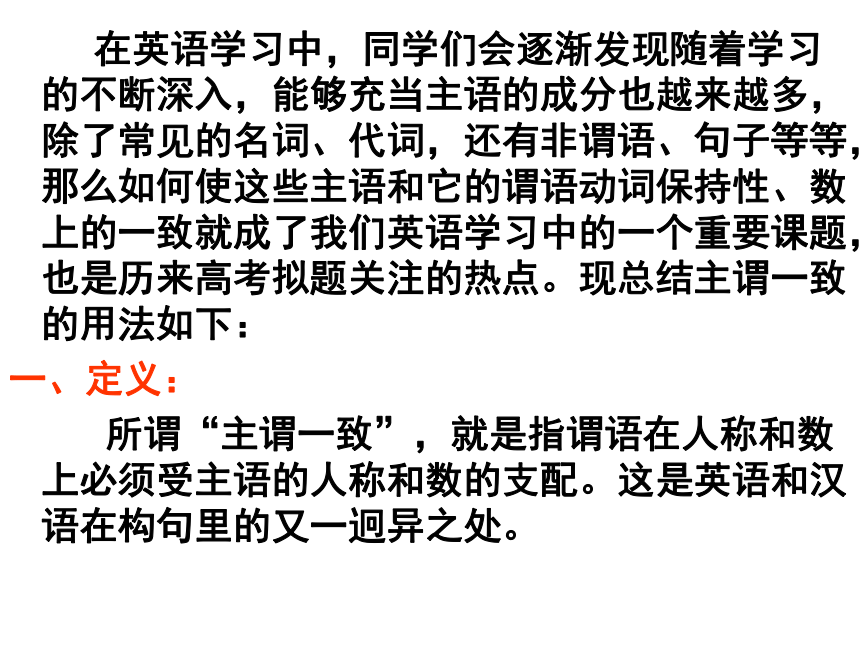
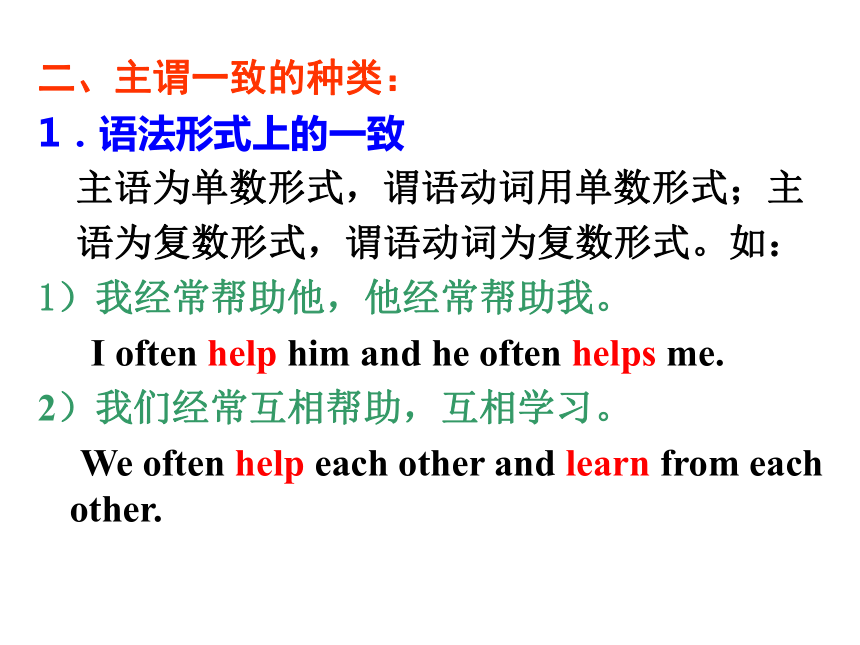
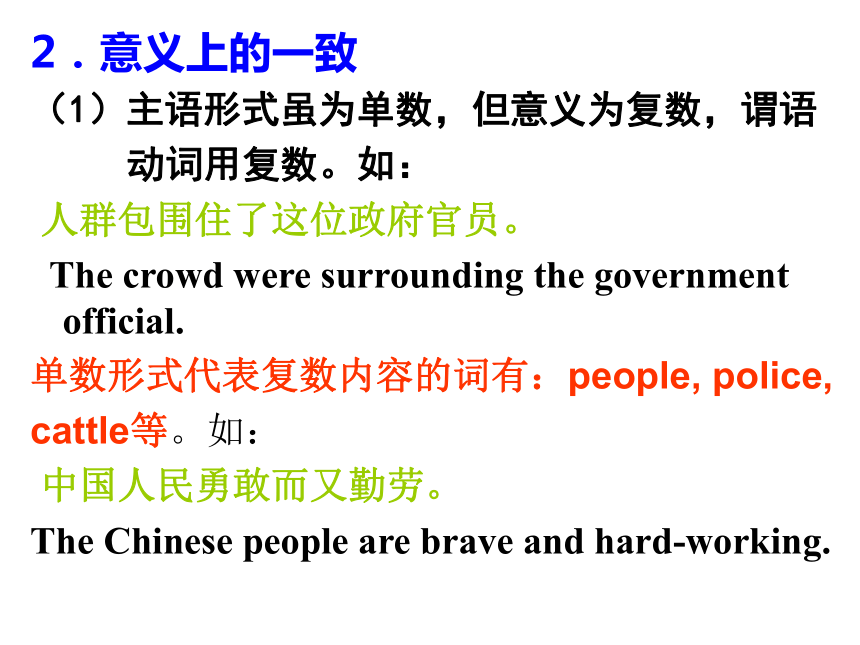



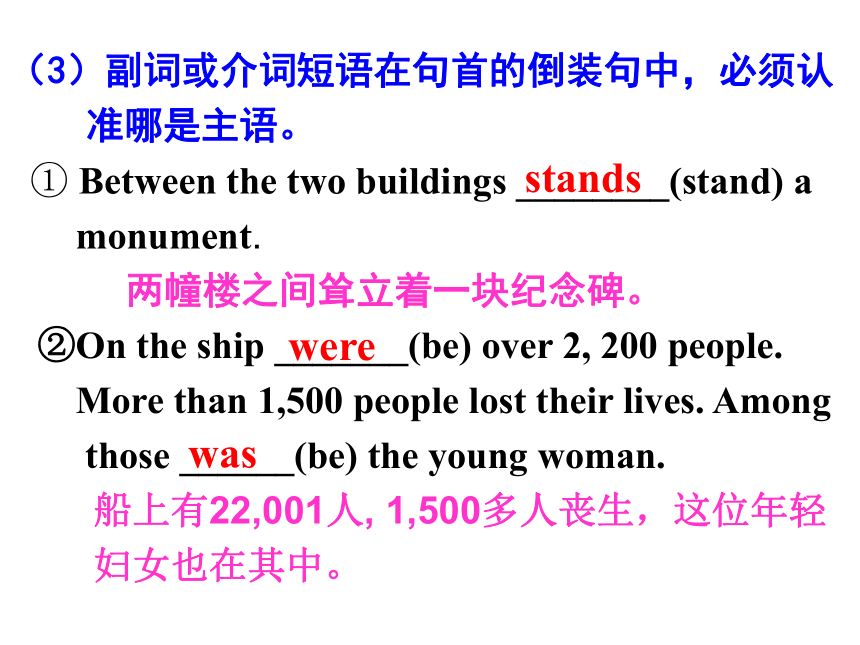
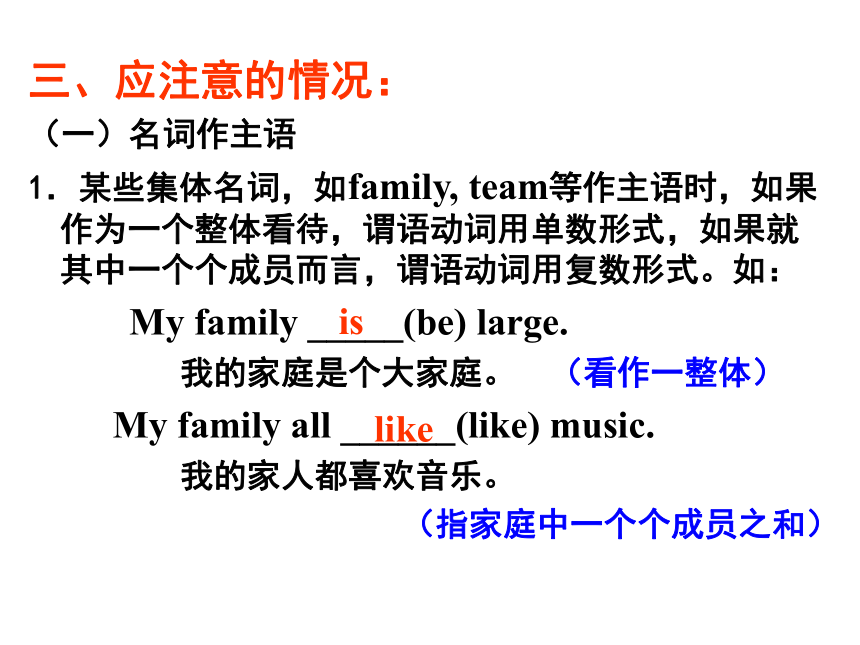
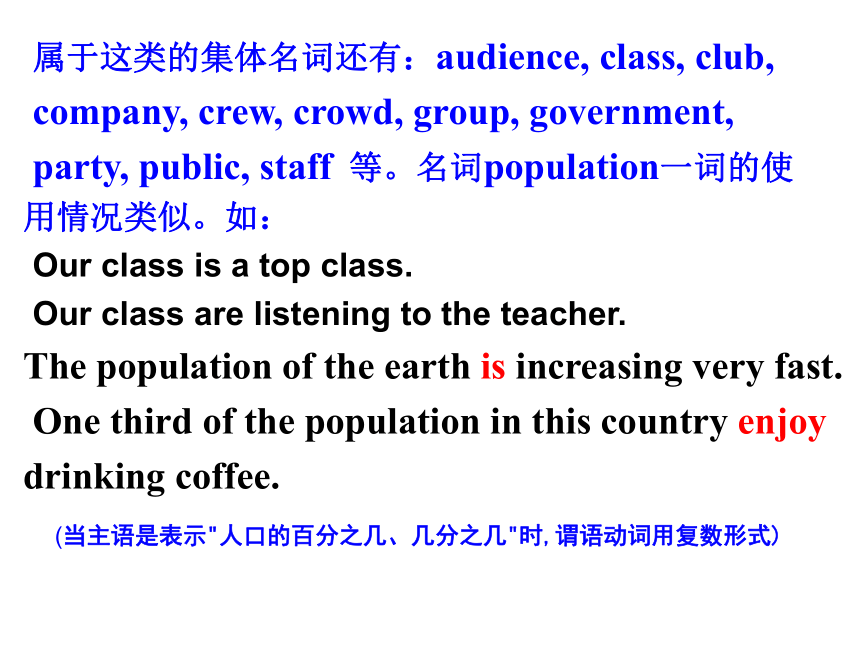
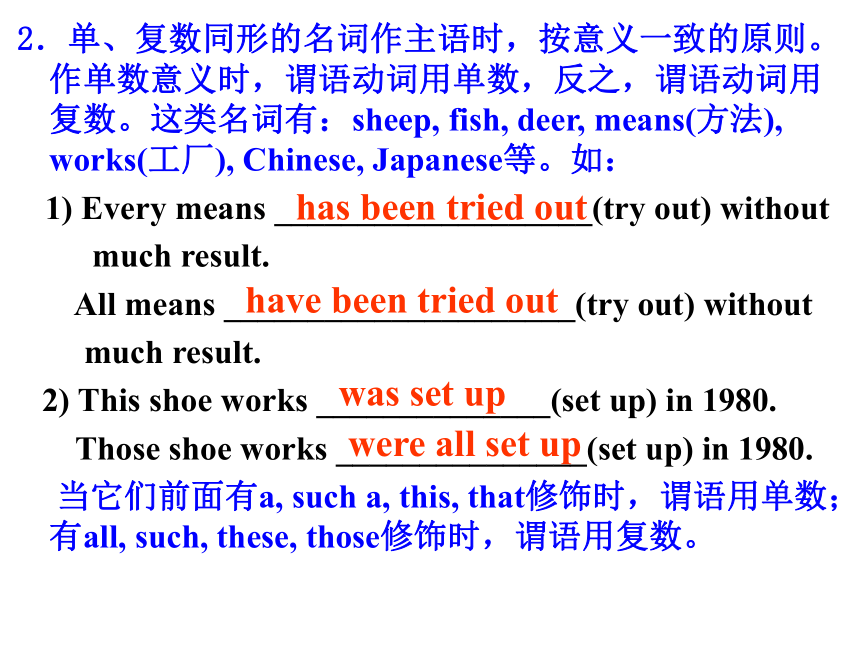
文档简介
课件50张PPT。2015高考英语第一轮总复习主谓一致 在英语学习中,同学们会逐渐发现随着学习的不断深入,能够充当主语的成分也越来越多,除了常见的名词、代词,还有非谓语、句子等等,那么如何使这些主语和它的谓语动词保持性、数上的一致就成了我们英语学习中的一个重要课题,也是历来高考拟题关注的热点。现总结主谓一致的用法如下:
一、定义:
所谓“主谓一致”,就是指谓语在人称和数上必须受主语的人称和数的支配。这是英语和汉语在构句里的又一迥异之处。二、主谓一致的种类:
1.语法形式上的一致
主语为单数形式,谓语动词用单数形式;主
语为复数形式,谓语动词为复数形式。如:
1)我经常帮助他,他经常帮助我。
I often help him and he often helps me.
2)我们经常互相帮助,互相学习。
We often help each other and learn from each other.2.意义上的一致
(1)主语形式虽为单数,但意义为复数,谓语
动词用复数。如:
人群包围住了这位政府官员。
The crowd were surrounding the government official.
单数形式代表复数内容的词有:people, police,
cattle等。如:
中国人民勇敢而又勤劳。
The Chinese people are brave and hard-working.
(2)主语形式为复数,而意义上却是单数,谓
语动词用单数。如:
《远大前程》是查尔斯·狄更斯1860年所著。
Great Expectations ___( be) written by Charles
Dickens in 1860.
形复意单的单词有:news, works(著作) 和一些以s结尾的书名、组织机构的名称(如:“The Selected Poems of Li Bai”, the United States, the United
Nations)以及以ics结尾的学科名称(如:
physics, politics, maths, economics等)。
was3.就近原则
就近原则即谓语动词的单、复数形式取决于最靠近它的词语。
(1)并列主语用连词or, either…or…, neither…nor…, not only…but also…等连接,谓语应同相邻的主语保持人称和数的一致。如:
1) Bob or his parents _____(be) waiting in the
room now.
2) Not only the students but also the teacher
________(enjoy) listening to the music.
3) Either you or he _____ (be) wrong?
______(be )either you or he wrong?
areenjoysAre is(2)在there be 表存在的句式中,主语是两个
或多个名词(短语)的并列时,be 的形
式与最前边的一个名词(短语)一致。如:
There _____(be) a pen, two knives and several books on the table.
=There ______(be) two knives, a pen and several books on the table.
桌子上有一支钢笔、两把小刀和几本书。is are(3)副词或介词短语在句首的倒装句中,必须认
准哪是主语。
① Between the two buildings ________(stand) a
monument.
两幢楼之间耸立着一块纪念碑。
②On the ship _______(be) over 2, 200 people.
More than 1,500 people lost their lives. Among
those ______(be) the young woman.
船上有22,001人, 1,500多人丧生,这位年轻
妇女也在其中。
standswerewas三、应注意的情况:
(一)名词作主语
1.某些集体名词,如family, team等作主语时,如果作为一个整体看待,谓语动词用单数形式,如果就其中一个个成员而言,谓语动词用复数形式。如:
My family _____(be) large.
我的家庭是个大家庭。 (看作一整体)
My family all ______(like) music.
我的家人都喜欢音乐。
(指家庭中一个个成员之和)islike 属于这类的集体名词还有:audience, class, club,
company, crew, crowd, group, government,
party, public, staff 等。名词population一词的使
用情况类似。如:
Our class is a top class.
Our class are listening to the teacher.
The population of the earth is increasing very fast.
One third of the population in this country enjoy
drinking coffee.
(当主语是表示"人口的百分之几、几分之几"时,谓语动词用复数形式) 2.单、复数同形的名词作主语时,按意义一致的原则。作单数意义时,谓语动词用单数,反之,谓语动词用复数。这类名词有:sheep, fish, deer, means(方法), works(工厂), Chinese, Japanese等。如:
1) Every means ___________________(try out) without
much result.
All means _____________________(try out) without
much result.
2) This shoe works ______________(set up) in 1980.
Those shoe works _______________(set up) in 1980.
当它们前面有a, such a, this, that修饰时,谓语用单数;有all, such, these, those修饰时,谓语用复数。has been tried outhave been tried outwas set upwere all set up3.名词所有格之后的名词被省略,这种情况一
般指商店、工场、住宅等,作主语时,谓语
动词一般用单数。如:
My doctor’s is not far from my home.
我的家庭医生诊所离我家不远。
My uncle’s is just across the street.
常见的省略名词有:the baker’s, the barber’s,
the carpenter’s, the Smith’s 等等。
4.当名词词组中心词为表示度量、距离、金额、时间等复数名词时,往往可以根据意义一致的原则,把这些复数名词看作一个整体,谓语动词用单数形式。如:
① Two hours ____(be) enough for me to finish
the work.
两小时对我来说完成这项工作足够了。
②Two hundred dollars ______(give) Jack much
help.
两百美元帮了Jack大忙。isgives5.如果主语有more than one… 或many a…构成,
尽管从意义上看是复数内容,但它的谓语动词仍
然用单数形式。如:
More than one comrade has asked to stay.
不止一位同志已经要求留下。
Many a passenger was killed in the accident.
许多乘客在这一次事故中丧生。
但是“more+复数名词+than one”结构及“more than
one hundred+复数名词”结构之后,谓语动词一般用
复数形式。如:
More members than one are against your plan.
不止一位成员反对你的计划。More than one hundred people have been there.6.不定代词each, every, no所修饰的名词及
each…and each…, every…and every…,
no…and no…, many a …and many a…结构
作主语时,谓语动词仍用单数形式。如:
Every man and every woman _____(be) at work.
所有男的和女的都在工作。
Many a desk and many a bench _____(be) to be taken out of the hall.
许多课桌和凳子将被搬出大厅。
isis7. 表示成双成套的名词,如:chopsticks (筷子),
compasses(圆规), clothes, glasses, jeans,
scissors(剪刀), shoes, socks, trousers等,作主语时,
谓语动词通常用复数形式;但如与a kind of,
a pair of, the pair of, a series of 连用,作主语时,谓
语动词用单数形式。如:
The trousers are in the drawer.
There is a pair of shoes under the bed.
The pair of shoes is rather expensive. 8. this kind of book = a book of this kind (这种
书),其谓语动词用单数;短语this kind of books
= books of this kind(这类书),但this kind of
books作主语时,谓语动词用单数;books of this
kind 语时,谓语动词用复数。all/these kinds of 后
跟复数名词,谓语动词用复数形式。如:
This kind of books _____very popular with young people.
这类书很受年轻人欢迎。
Books of this kind ______very popular with young people.
All kinds of flowers _______________(come out)in the valley already.isarehave come out9.如果名词词组的中心词是all, most, rest, some, neither, none, no等词,所指是复数意义,谓语动词用复数形式;反之用单数。如:
Some of the pigeons ____________(be) missing.
Some of the ice __________(melt) so far.
All of the water in the area has been seriously polluted.
All of the books have been sold out.
None of us have been there.
None of the stolen money has been found yet.
The rest of the students are watering trees.
The rest of the wine has gone bad.
have beenhas melted(二)由连接词连接的名词作主语
1.用and或both…and连接并列主语,表示不
同概念,谓语动词常用复数。如:
1) 你和他都站了起来。
You and he both stand up.
2) 水和空气都很重要。
Water and air are both important.
3) 岁月不待人。
Time and tide wait for no man. 但并列结构充当主语表示整体概念时,即指的是同一人,同一物或同一概念,谓语动词用单数形式,这时and后面的名词没有冠词。
英语中并列结构表示整体概念的有:
(1)相关名词并列表示整体概念。如:
iron and steel 钢铁 law and order 治安
bread and butter 黄油面包
(2)配套事物。如:
a watch and chain 一块带链的表
a needle and thread 针线
a coat and tie 配有领带的上衣
A knife and fork is needed for a western meal.
吃西餐时要用刀和叉。
The cart and horse is coming.
马车来了。(3)表示兼职或有多个称呼的人。如:
The worker and poet is his father.
这位工人兼诗人是他父亲.
这位教师兼作家正在会上发言。
The writer and teacher is speaking at the meeting.
(4)两个完全重合的概念并列。如:
目的 aim and end
真诚 truth and honesty
效能 capacity and efficiency
情感 love and affection
爱与被爱是幸福。
To love and to be loved is the great happiness.
早睡早起是好习惯。
Going to bed early and getting up early is a good habit.
2.当主语后面跟有as well as, as much as, no less than, along with, with, like, rather than, together with, but, except, besides, including, in addition to等引导的词组时,其谓语动词的单、复数按主语的单、复数而定。如:
1) 不仅你而且你的父亲对我都非常好。
Your father as well as you is very kind to me.
2) 他象你和小李一样非常聪明。
He, like you and Xiao Li, is very clever.
3) Robbins先生明天将和妻子和孩子离开伦敦去巴黎。
Mr. Robbins, together with his wife and
children, is leaving London for Paris.
(三) 代词作主语
1.名词性物主代词作主语时,根据它所替代的
是单数还是复数来确定谓语动词的单、复数。
如:
Theirs (their classroom) is a big classroom.
他们的教室是一个大教室。
Your trousers are black and mine are brown.
2.such, the same起指示代词作用,应根据其所指
的内容来确定单、复数。如:
这就是我们的计划。
Such is our plan.
这些就是我的愿望。
Such are my hopes.
The same has/ have happened.
3.关系代词which, who, that在定语从句中作主语时,其谓语动词的数应与其前的先行词的数保持一致。如:
1) Those who ______(want) to go should sign
your names here.
2) He is one of the students who______(be) good
at maths.
3) He is the only one of the children who often
______(speak) ill of others behind their backs.
wantarespeaks4.疑问代词who, what, which作主语时,谓语动
词可以根据说话人所要表达的意思决定单、复
数。如:
Who lives next door? It’s Xiao Liu.
Who live next door? It’s Zhang and Liu.
What is urgently wanted? It’s money.
What are urgently wanted? It’s more books.
5.不定代词any, either, neither, none, all, some,
more等作主语时,有以下两种情况:
1) 单独作主语,视其在文中的意义,动词可用
单数或复数形式。例如:
Now all has been changed.
All are present at the meeting.
Some are my old classmates.
He gave me much advice.Some has been accepted.
2) either, neither单独作主语,谓语通常用单数。
但是后接of时,若of的宾语为不可数名词,谓
语动词当然用单数形式,若of的宾语为复数名
词或代词时,动词可以是单数,也可以是复
数,在正式文体中,单数形式的动词更为常用。
他们中有人懂英语吗?
Does (Do) any of them know English?
他们中没人喜欢足球。
None of them likes (like) football.
(四)分数、量词作主语
“分数或百分数+of+名词”构成的短语及由“a
lot of, lots of, plenty of, half of +名词”构成的
短语作主语时,谓语动词的数与短语中of后面
的名词的数保持一致。如:
1) More than 70 percent of the surface of our
planet___________ (cover) by water.
我们星球的表面百分之七十多都被水覆盖着。
2) One third of the students ______(be) girls in
our group. is coveredare注意:
a large quantity of 修饰可数名词或不可数名词,
其短语作主语,谓语动词用单数,而(large)
quantities of修饰可数名词或不可数名词,其短语
作主语,谓语动词一般用复数。如:
1) A large quantity of people _________(need) here.
2) Large quantities of food ____________(rot) away.
3)Vast amounts of money are being invested in the local market now.
4) A large amount of money is spent on the project.
is neededhave rotten 归纳
1)当“an amount of / a quantity of+不可数名词”作主语
时,谓语动词要用单数形式。
2)当“quantities of / amounts of+不可数名词”作主语
时,谓语动词要用复数形式。
3)“a large amount/quantity of+不可数名词”作主语与单
数动词连用。
4)“large amounts/quantities of+不可数名词”作主语与复
数动词连用。
2.a great deal of/ a large amount of修饰不可数名
词,其短语作主语时,谓语动词用单数形式,
但large amounts of 修饰不可数名词,其短语作
主语时,谓语动词常用复数形式。如:
1) Once a great deal of rice __________(take) from the country to the city by railway.
2) Large amounts of money __________(spend)on
the bridge.
was takenwere spent3.“a number of+复数名词”作主语,谓语动词
用复数;“the number of+复数名词”作主语,
谓语动词用单数。如:
A number of students are going for a picnic this weekend.
这个周末许多学生将去野炊。
The number of days in February this year is 28.4.one and a half后,名词要用复数形式,但其短语作主语时,谓语动词用单数形式。如:
One and a half bananas has been eaten by the child.
An hour and a half is enough.5.half of, (a) part of修饰可数名词单数及不可数名词作主语时,谓语动词用单数,修饰可数名词复数作主语时,谓语动词用复数。如:
Half of the building is finished.
这幢大楼已经建了一半。
Part of the glasses in the store are made
in Suzhou.(五)名词化的形容词作主语
“the+形容词(或过去分词或现在分词)”如:
the brave, the poor, the rich, the blind, the young,
the old, the sick, the wounded, the injured, the
unemployed, the dying, the living 等结构担任主语
表示一类人时,谓语动词常用复数形式;但也有少数的
形容词或过去分词与定冠词连用指个别或表示抽象的概念
时,谓语动词用单数。如:
The young are more active than the old in the work.
The injured in the accident is an engineer.
The beautiful attracts all the tourists.六)动名词、不定式短语和从句作主语,谓语动词
用单数形式。如:
1) To learn a foreign language is not so difficult as you
think.
2) Smoking is bad for health.
3) 他赢了这场比赛是我们众所周知的事。
That he has won the game is known to us all.
但what引导的主语从句所指的具体内容是复数意义时,
谓语动词一般用复数形式。如:
What we need is more time.
我们需要的是更多的时间。
What we need are good teachers. 在“one of +复数名词+who/ that/ which”引导的定语从
句中,关系代词who/ that/ which的先行词是靠近它的复
数名词而不是one,因此,从句中的动词应该是复数形式。
例如:
This is one of the most interesting questions that
________________(ask).
但是当one之前有the only等修饰语时,关系代词的先行
词是one,而不是靠近它的复数名词,因此从句的动词应
是单数形式。例如:
She was the only of the girls who _______late for
the meeting.have been askedwas
主要考查考生对基础知识的掌握和语言运用的能力,以及在长句中判断主语中心词的能力,重点在掌握主谓一致三大原则(语法一致,意义一致和就近原则) .主谓一致1. The number of people invited ______ fifty , but a number of them ____ absent for different reasons .
A. were ; was B. was ; was
C. was ; were D. were ; were
2. He is the only one of the students who _____ a winner of scholarship for three years .
A. is B. are
C. have been D. has been 3.The father as well as his three children _____ skating on the frozen river every Sundry afternoon in winter .(06辽宁)
A. is going B. go
C. goes D. are going
4. The teacher , with 6 girls and 8 boys of her class , ___ visiting a museum when the earthquake struck .(04北京)
A. was B. were
C. had been D. would be
no less than , rather than , more than , but , except , besides , along with , together with , like, including , in addition to , etc 5.Nowadays , a large number of women , especially those from the countryside , _____ in the clothing industry .(05辽宁)
A. is working B. works
C. work D. worked
6. Most of what has been said about the Smiths _____ also true of the Johnsons .
A. are B. is C. being D. to be
7. A poet and artist ____ coming to speak to us about Chinese literature and painting tomorrow afternoon .(06 江苏)
A. is B. are C. was D. were 8. The construction of the two new railway lines ____ by now .(06陕西)
A. has been completed
B. have been completed
C. has completed D. have completed
9. No one in the department but Tom and I ____ that the director is going to resign .
A. knows B. know
C. have known D. am to know
10. On the top of the books _____ the photo album you’re looking for .
A. has B. have C. is D. are 11. More than one person _____ made the same suggestion .
A. was B. were C. has D. have
12. Although the injured ____ sent to hospital immediately , it was a little late to save him .
A. were B. weren’t
C. was D. wasn’t
13. The town had organized a team of 40 people , but about two-thirds ____ women.
A. is B. are C. was D. were 14. – Why are you always borrowing money?
-- You know , large quantities of money _____ in renting a house every month .
A. is spent B. are spent
C. was spent D. were spent
15. He is one of the students who ____ here , and he is the only one of the boy students who _____ here on time .
A. has come ; have come
B. has come ; has come
C. have come ; has come
D. have come ; have come 16. My family ___ very large and my family ____ all fond of going to the cinema .
A. is ; is B. are ; are
C. are ; is D. is ; are
17. Nowadays the number of people who ____ cars _____ increasing .
A. own ; are B. own ; is
C. own ; were D. owns ; will be
18. Not only I but also Li Ming and Wang Kai ____ fond of playing basketball .
A. is B. are C. have D. has19.When and where to hold the meeting _____ yet .
A. is not decided B. are not decided
C. has not been decided
D. have not been decided
20. Since each boy and each girl ____ about it already , all we can do is to wait till they forget it again .
A. know B. knows
C. knowing D. having known
21. Let’s walk to school . After all , 400 metres ____ not a long way to go on foot .
A. is B. are C. has D. have22.Every possible means ____ to prevent the air pollution , but the sky is still not clear .
A. is used B. are used
C. has been used D. have been used
23. Each of the students , working hard at his or her lessons , ____ to go to university . So do I .
A. hope B. hopes
C. hoping D. hoped
24. Either you or the headmaster ____ the prize to these gifted students at the meeting .
A. is handing out C. are handing out
B. are to hand out D. is to hand out25. All but one ____ here just now .
A. is B. was C. has been D. were
26. Money ___ something , not everything , but without money , you can’t do anything in this world .
A. is B. was
C. are D. were
一、定义:
所谓“主谓一致”,就是指谓语在人称和数上必须受主语的人称和数的支配。这是英语和汉语在构句里的又一迥异之处。二、主谓一致的种类:
1.语法形式上的一致
主语为单数形式,谓语动词用单数形式;主
语为复数形式,谓语动词为复数形式。如:
1)我经常帮助他,他经常帮助我。
I often help him and he often helps me.
2)我们经常互相帮助,互相学习。
We often help each other and learn from each other.2.意义上的一致
(1)主语形式虽为单数,但意义为复数,谓语
动词用复数。如:
人群包围住了这位政府官员。
The crowd were surrounding the government official.
单数形式代表复数内容的词有:people, police,
cattle等。如:
中国人民勇敢而又勤劳。
The Chinese people are brave and hard-working.
(2)主语形式为复数,而意义上却是单数,谓
语动词用单数。如:
《远大前程》是查尔斯·狄更斯1860年所著。
Great Expectations ___( be) written by Charles
Dickens in 1860.
形复意单的单词有:news, works(著作) 和一些以s结尾的书名、组织机构的名称(如:“The Selected Poems of Li Bai”, the United States, the United
Nations)以及以ics结尾的学科名称(如:
physics, politics, maths, economics等)。
was3.就近原则
就近原则即谓语动词的单、复数形式取决于最靠近它的词语。
(1)并列主语用连词or, either…or…, neither…nor…, not only…but also…等连接,谓语应同相邻的主语保持人称和数的一致。如:
1) Bob or his parents _____(be) waiting in the
room now.
2) Not only the students but also the teacher
________(enjoy) listening to the music.
3) Either you or he _____ (be) wrong?
______(be )either you or he wrong?
areenjoysAre is(2)在there be 表存在的句式中,主语是两个
或多个名词(短语)的并列时,be 的形
式与最前边的一个名词(短语)一致。如:
There _____(be) a pen, two knives and several books on the table.
=There ______(be) two knives, a pen and several books on the table.
桌子上有一支钢笔、两把小刀和几本书。is are(3)副词或介词短语在句首的倒装句中,必须认
准哪是主语。
① Between the two buildings ________(stand) a
monument.
两幢楼之间耸立着一块纪念碑。
②On the ship _______(be) over 2, 200 people.
More than 1,500 people lost their lives. Among
those ______(be) the young woman.
船上有22,001人, 1,500多人丧生,这位年轻
妇女也在其中。
standswerewas三、应注意的情况:
(一)名词作主语
1.某些集体名词,如family, team等作主语时,如果作为一个整体看待,谓语动词用单数形式,如果就其中一个个成员而言,谓语动词用复数形式。如:
My family _____(be) large.
我的家庭是个大家庭。 (看作一整体)
My family all ______(like) music.
我的家人都喜欢音乐。
(指家庭中一个个成员之和)islike 属于这类的集体名词还有:audience, class, club,
company, crew, crowd, group, government,
party, public, staff 等。名词population一词的使
用情况类似。如:
Our class is a top class.
Our class are listening to the teacher.
The population of the earth is increasing very fast.
One third of the population in this country enjoy
drinking coffee.
(当主语是表示"人口的百分之几、几分之几"时,谓语动词用复数形式) 2.单、复数同形的名词作主语时,按意义一致的原则。作单数意义时,谓语动词用单数,反之,谓语动词用复数。这类名词有:sheep, fish, deer, means(方法), works(工厂), Chinese, Japanese等。如:
1) Every means ___________________(try out) without
much result.
All means _____________________(try out) without
much result.
2) This shoe works ______________(set up) in 1980.
Those shoe works _______________(set up) in 1980.
当它们前面有a, such a, this, that修饰时,谓语用单数;有all, such, these, those修饰时,谓语用复数。has been tried outhave been tried outwas set upwere all set up3.名词所有格之后的名词被省略,这种情况一
般指商店、工场、住宅等,作主语时,谓语
动词一般用单数。如:
My doctor’s is not far from my home.
我的家庭医生诊所离我家不远。
My uncle’s is just across the street.
常见的省略名词有:the baker’s, the barber’s,
the carpenter’s, the Smith’s 等等。
4.当名词词组中心词为表示度量、距离、金额、时间等复数名词时,往往可以根据意义一致的原则,把这些复数名词看作一个整体,谓语动词用单数形式。如:
① Two hours ____(be) enough for me to finish
the work.
两小时对我来说完成这项工作足够了。
②Two hundred dollars ______(give) Jack much
help.
两百美元帮了Jack大忙。isgives5.如果主语有more than one… 或many a…构成,
尽管从意义上看是复数内容,但它的谓语动词仍
然用单数形式。如:
More than one comrade has asked to stay.
不止一位同志已经要求留下。
Many a passenger was killed in the accident.
许多乘客在这一次事故中丧生。
但是“more+复数名词+than one”结构及“more than
one hundred+复数名词”结构之后,谓语动词一般用
复数形式。如:
More members than one are against your plan.
不止一位成员反对你的计划。More than one hundred people have been there.6.不定代词each, every, no所修饰的名词及
each…and each…, every…and every…,
no…and no…, many a …and many a…结构
作主语时,谓语动词仍用单数形式。如:
Every man and every woman _____(be) at work.
所有男的和女的都在工作。
Many a desk and many a bench _____(be) to be taken out of the hall.
许多课桌和凳子将被搬出大厅。
isis7. 表示成双成套的名词,如:chopsticks (筷子),
compasses(圆规), clothes, glasses, jeans,
scissors(剪刀), shoes, socks, trousers等,作主语时,
谓语动词通常用复数形式;但如与a kind of,
a pair of, the pair of, a series of 连用,作主语时,谓
语动词用单数形式。如:
The trousers are in the drawer.
There is a pair of shoes under the bed.
The pair of shoes is rather expensive. 8. this kind of book = a book of this kind (这种
书),其谓语动词用单数;短语this kind of books
= books of this kind(这类书),但this kind of
books作主语时,谓语动词用单数;books of this
kind 语时,谓语动词用复数。all/these kinds of 后
跟复数名词,谓语动词用复数形式。如:
This kind of books _____very popular with young people.
这类书很受年轻人欢迎。
Books of this kind ______very popular with young people.
All kinds of flowers _______________(come out)in the valley already.isarehave come out9.如果名词词组的中心词是all, most, rest, some, neither, none, no等词,所指是复数意义,谓语动词用复数形式;反之用单数。如:
Some of the pigeons ____________(be) missing.
Some of the ice __________(melt) so far.
All of the water in the area has been seriously polluted.
All of the books have been sold out.
None of us have been there.
None of the stolen money has been found yet.
The rest of the students are watering trees.
The rest of the wine has gone bad.
have beenhas melted(二)由连接词连接的名词作主语
1.用and或both…and连接并列主语,表示不
同概念,谓语动词常用复数。如:
1) 你和他都站了起来。
You and he both stand up.
2) 水和空气都很重要。
Water and air are both important.
3) 岁月不待人。
Time and tide wait for no man. 但并列结构充当主语表示整体概念时,即指的是同一人,同一物或同一概念,谓语动词用单数形式,这时and后面的名词没有冠词。
英语中并列结构表示整体概念的有:
(1)相关名词并列表示整体概念。如:
iron and steel 钢铁 law and order 治安
bread and butter 黄油面包
(2)配套事物。如:
a watch and chain 一块带链的表
a needle and thread 针线
a coat and tie 配有领带的上衣
A knife and fork is needed for a western meal.
吃西餐时要用刀和叉。
The cart and horse is coming.
马车来了。(3)表示兼职或有多个称呼的人。如:
The worker and poet is his father.
这位工人兼诗人是他父亲.
这位教师兼作家正在会上发言。
The writer and teacher is speaking at the meeting.
(4)两个完全重合的概念并列。如:
目的 aim and end
真诚 truth and honesty
效能 capacity and efficiency
情感 love and affection
爱与被爱是幸福。
To love and to be loved is the great happiness.
早睡早起是好习惯。
Going to bed early and getting up early is a good habit.
2.当主语后面跟有as well as, as much as, no less than, along with, with, like, rather than, together with, but, except, besides, including, in addition to等引导的词组时,其谓语动词的单、复数按主语的单、复数而定。如:
1) 不仅你而且你的父亲对我都非常好。
Your father as well as you is very kind to me.
2) 他象你和小李一样非常聪明。
He, like you and Xiao Li, is very clever.
3) Robbins先生明天将和妻子和孩子离开伦敦去巴黎。
Mr. Robbins, together with his wife and
children, is leaving London for Paris.
(三) 代词作主语
1.名词性物主代词作主语时,根据它所替代的
是单数还是复数来确定谓语动词的单、复数。
如:
Theirs (their classroom) is a big classroom.
他们的教室是一个大教室。
Your trousers are black and mine are brown.
2.such, the same起指示代词作用,应根据其所指
的内容来确定单、复数。如:
这就是我们的计划。
Such is our plan.
这些就是我的愿望。
Such are my hopes.
The same has/ have happened.
3.关系代词which, who, that在定语从句中作主语时,其谓语动词的数应与其前的先行词的数保持一致。如:
1) Those who ______(want) to go should sign
your names here.
2) He is one of the students who______(be) good
at maths.
3) He is the only one of the children who often
______(speak) ill of others behind their backs.
wantarespeaks4.疑问代词who, what, which作主语时,谓语动
词可以根据说话人所要表达的意思决定单、复
数。如:
Who lives next door? It’s Xiao Liu.
Who live next door? It’s Zhang and Liu.
What is urgently wanted? It’s money.
What are urgently wanted? It’s more books.
5.不定代词any, either, neither, none, all, some,
more等作主语时,有以下两种情况:
1) 单独作主语,视其在文中的意义,动词可用
单数或复数形式。例如:
Now all has been changed.
All are present at the meeting.
Some are my old classmates.
He gave me much advice.Some has been accepted.
2) either, neither单独作主语,谓语通常用单数。
但是后接of时,若of的宾语为不可数名词,谓
语动词当然用单数形式,若of的宾语为复数名
词或代词时,动词可以是单数,也可以是复
数,在正式文体中,单数形式的动词更为常用。
他们中有人懂英语吗?
Does (Do) any of them know English?
他们中没人喜欢足球。
None of them likes (like) football.
(四)分数、量词作主语
“分数或百分数+of+名词”构成的短语及由“a
lot of, lots of, plenty of, half of +名词”构成的
短语作主语时,谓语动词的数与短语中of后面
的名词的数保持一致。如:
1) More than 70 percent of the surface of our
planet___________ (cover) by water.
我们星球的表面百分之七十多都被水覆盖着。
2) One third of the students ______(be) girls in
our group. is coveredare注意:
a large quantity of 修饰可数名词或不可数名词,
其短语作主语,谓语动词用单数,而(large)
quantities of修饰可数名词或不可数名词,其短语
作主语,谓语动词一般用复数。如:
1) A large quantity of people _________(need) here.
2) Large quantities of food ____________(rot) away.
3)Vast amounts of money are being invested in the local market now.
4) A large amount of money is spent on the project.
is neededhave rotten 归纳
1)当“an amount of / a quantity of+不可数名词”作主语
时,谓语动词要用单数形式。
2)当“quantities of / amounts of+不可数名词”作主语
时,谓语动词要用复数形式。
3)“a large amount/quantity of+不可数名词”作主语与单
数动词连用。
4)“large amounts/quantities of+不可数名词”作主语与复
数动词连用。
2.a great deal of/ a large amount of修饰不可数名
词,其短语作主语时,谓语动词用单数形式,
但large amounts of 修饰不可数名词,其短语作
主语时,谓语动词常用复数形式。如:
1) Once a great deal of rice __________(take) from the country to the city by railway.
2) Large amounts of money __________(spend)on
the bridge.
was takenwere spent3.“a number of+复数名词”作主语,谓语动词
用复数;“the number of+复数名词”作主语,
谓语动词用单数。如:
A number of students are going for a picnic this weekend.
这个周末许多学生将去野炊。
The number of days in February this year is 28.4.one and a half后,名词要用复数形式,但其短语作主语时,谓语动词用单数形式。如:
One and a half bananas has been eaten by the child.
An hour and a half is enough.5.half of, (a) part of修饰可数名词单数及不可数名词作主语时,谓语动词用单数,修饰可数名词复数作主语时,谓语动词用复数。如:
Half of the building is finished.
这幢大楼已经建了一半。
Part of the glasses in the store are made
in Suzhou.(五)名词化的形容词作主语
“the+形容词(或过去分词或现在分词)”如:
the brave, the poor, the rich, the blind, the young,
the old, the sick, the wounded, the injured, the
unemployed, the dying, the living 等结构担任主语
表示一类人时,谓语动词常用复数形式;但也有少数的
形容词或过去分词与定冠词连用指个别或表示抽象的概念
时,谓语动词用单数。如:
The young are more active than the old in the work.
The injured in the accident is an engineer.
The beautiful attracts all the tourists.六)动名词、不定式短语和从句作主语,谓语动词
用单数形式。如:
1) To learn a foreign language is not so difficult as you
think.
2) Smoking is bad for health.
3) 他赢了这场比赛是我们众所周知的事。
That he has won the game is known to us all.
但what引导的主语从句所指的具体内容是复数意义时,
谓语动词一般用复数形式。如:
What we need is more time.
我们需要的是更多的时间。
What we need are good teachers. 在“one of +复数名词+who/ that/ which”引导的定语从
句中,关系代词who/ that/ which的先行词是靠近它的复
数名词而不是one,因此,从句中的动词应该是复数形式。
例如:
This is one of the most interesting questions that
________________(ask).
但是当one之前有the only等修饰语时,关系代词的先行
词是one,而不是靠近它的复数名词,因此从句的动词应
是单数形式。例如:
She was the only of the girls who _______late for
the meeting.have been askedwas
主要考查考生对基础知识的掌握和语言运用的能力,以及在长句中判断主语中心词的能力,重点在掌握主谓一致三大原则(语法一致,意义一致和就近原则) .主谓一致1. The number of people invited ______ fifty , but a number of them ____ absent for different reasons .
A. were ; was B. was ; was
C. was ; were D. were ; were
2. He is the only one of the students who _____ a winner of scholarship for three years .
A. is B. are
C. have been D. has been 3.The father as well as his three children _____ skating on the frozen river every Sundry afternoon in winter .(06辽宁)
A. is going B. go
C. goes D. are going
4. The teacher , with 6 girls and 8 boys of her class , ___ visiting a museum when the earthquake struck .(04北京)
A. was B. were
C. had been D. would be
no less than , rather than , more than , but , except , besides , along with , together with , like, including , in addition to , etc 5.Nowadays , a large number of women , especially those from the countryside , _____ in the clothing industry .(05辽宁)
A. is working B. works
C. work D. worked
6. Most of what has been said about the Smiths _____ also true of the Johnsons .
A. are B. is C. being D. to be
7. A poet and artist ____ coming to speak to us about Chinese literature and painting tomorrow afternoon .(06 江苏)
A. is B. are C. was D. were 8. The construction of the two new railway lines ____ by now .(06陕西)
A. has been completed
B. have been completed
C. has completed D. have completed
9. No one in the department but Tom and I ____ that the director is going to resign .
A. knows B. know
C. have known D. am to know
10. On the top of the books _____ the photo album you’re looking for .
A. has B. have C. is D. are 11. More than one person _____ made the same suggestion .
A. was B. were C. has D. have
12. Although the injured ____ sent to hospital immediately , it was a little late to save him .
A. were B. weren’t
C. was D. wasn’t
13. The town had organized a team of 40 people , but about two-thirds ____ women.
A. is B. are C. was D. were 14. – Why are you always borrowing money?
-- You know , large quantities of money _____ in renting a house every month .
A. is spent B. are spent
C. was spent D. were spent
15. He is one of the students who ____ here , and he is the only one of the boy students who _____ here on time .
A. has come ; have come
B. has come ; has come
C. have come ; has come
D. have come ; have come 16. My family ___ very large and my family ____ all fond of going to the cinema .
A. is ; is B. are ; are
C. are ; is D. is ; are
17. Nowadays the number of people who ____ cars _____ increasing .
A. own ; are B. own ; is
C. own ; were D. owns ; will be
18. Not only I but also Li Ming and Wang Kai ____ fond of playing basketball .
A. is B. are C. have D. has19.When and where to hold the meeting _____ yet .
A. is not decided B. are not decided
C. has not been decided
D. have not been decided
20. Since each boy and each girl ____ about it already , all we can do is to wait till they forget it again .
A. know B. knows
C. knowing D. having known
21. Let’s walk to school . After all , 400 metres ____ not a long way to go on foot .
A. is B. are C. has D. have22.Every possible means ____ to prevent the air pollution , but the sky is still not clear .
A. is used B. are used
C. has been used D. have been used
23. Each of the students , working hard at his or her lessons , ____ to go to university . So do I .
A. hope B. hopes
C. hoping D. hoped
24. Either you or the headmaster ____ the prize to these gifted students at the meeting .
A. is handing out C. are handing out
B. are to hand out D. is to hand out25. All but one ____ here just now .
A. is B. was C. has been D. were
26. Money ___ something , not everything , but without money , you can’t do anything in this world .
A. is B. was
C. are D. were
